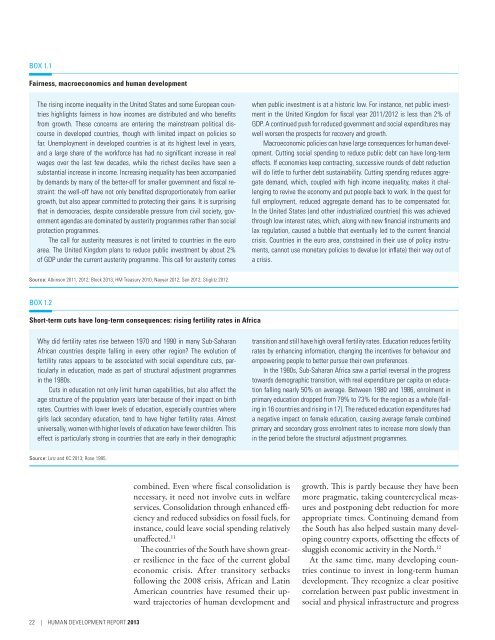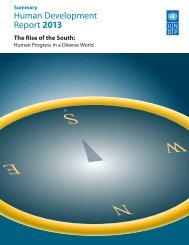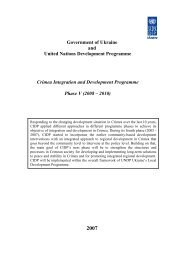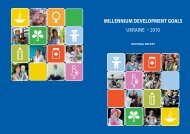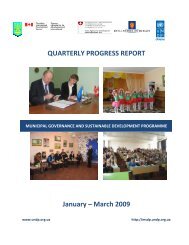E N S W - United Nations Development Programme
E N S W - United Nations Development Programme
E N S W - United Nations Development Programme
You also want an ePaper? Increase the reach of your titles
YUMPU automatically turns print PDFs into web optimized ePapers that Google loves.
Box 1.1<br />
Fairness, macroeconomics and human development<br />
The rising income inequality in the <strong>United</strong> States and some European countries<br />
highlights fairness in how incomes are distributed and who benefits<br />
from growth. These concerns are entering the mainstream political discourse<br />
in developed countries, though with limited impact on policies so<br />
far. Unemployment in developed countries is at its highest level in years,<br />
and a large share of the workforce has had no significant increase in real<br />
wages over the last few decades, while the richest deciles have seen a<br />
substantial increase in income. Increasing inequality has been accompanied<br />
by demands by many of the better- off for smaller government and fiscal restraint:<br />
the well-off have not only benefited disproportionately from earlier<br />
growth, but also appear committed to protecting their gains. It is surprising<br />
that in democracies, despite considerable pressure from civil society, government<br />
agendas are dominated by austerity programmes rather than social<br />
protection programmes.<br />
The call for austerity measures is not limited to countries in the euro<br />
area. The <strong>United</strong> Kingdom plans to reduce public investment by about 2%<br />
of GDP under the current austerity programme. This call for austerity comes<br />
when public investment is at a historic low. For instance, net public investment<br />
in the <strong>United</strong> Kingdom for fiscal year 2011/2012 is less than 2% of<br />
GDP. A continued push for reduced government and social expenditures may<br />
well worsen the prospects for recovery and growth.<br />
Macroeconomic policies can have large consequences for human development.<br />
Cutting social spending to reduce public debt can have long-term<br />
effects. If economies keep contracting, successive rounds of debt reduction<br />
will do little to further debt sustainability. Cutting spending reduces aggregate<br />
demand, which, coupled with high income inequality, makes it challenging<br />
to revive the economy and put people back to work. In the quest for<br />
full employment, reduced aggregate demand has to be compensated for.<br />
In the <strong>United</strong> States (and other industrialized countries) this was achieved<br />
through low interest rates, which, along with new financial instruments and<br />
lax regulation, caused a bubble that eventually led to the current financial<br />
crisis. Countries in the euro area, constrained in their use of policy instruments,<br />
cannot use monetary policies to devalue (or inflate) their way out of<br />
a crisis.<br />
Source: Atkinson 2011, 2012; Block 2013; HM Treasury 2010; Nayyar 2012; Sen 2012; Stiglitz 2012.<br />
Box 1.2<br />
Short-term cuts have long-term consequences: rising fertility rates in Africa<br />
Why did fertility rates rise between 1970 and 1990 in many Sub-Saharan<br />
African countries despite falling in every other region The evolution of<br />
fertility rates appears to be associated with social expenditure cuts, particularly<br />
in education, made as part of structural adjustment programmes<br />
in the 1980s.<br />
Cuts in education not only limit human capabilities, but also affect the<br />
age structure of the population years later because of their impact on birth<br />
rates. Countries with lower levels of education, especially countries where<br />
girls lack secondary education, tend to have higher fertility rates. Almost<br />
universally, women with higher levels of education have fewer children. This<br />
effect is particularly strong in countries that are early in their demographic<br />
transition and still have high overall fertility rates. Education reduces fertility<br />
rates by enhancing information, changing the incentives for behaviour and<br />
empowering people to better pursue their own preferences.<br />
In the 1980s, Sub-Saharan Africa saw a partial reversal in the progress<br />
towards demographic transition, with real expenditure per capita on education<br />
falling nearly 50% on average. Between 1980 and 1986, enrolment in<br />
primary education dropped from 79% to 73% for the region as a whole (falling<br />
in 16 countries and rising in 17). The reduced education expenditures had<br />
a negative impact on female education, causing average female combined<br />
primary and secondary gross enrolment rates to increase more slowly than<br />
in the period before the structural adjustment programmes.<br />
Source: Lutz and KC 2013; Rose 1995.<br />
combined. Even where fiscal consolidation is<br />
necessary, it need not involve cuts in welfare<br />
services. Consolidation through enhanced efficiency<br />
and reduced subsidies on fossil fuels, for<br />
instance, could leave social spending relatively<br />
unaffected. 11<br />
The countries of the South have shown greater<br />
resilience in the face of the current global<br />
economic crisis. After transitory setbacks<br />
following the 2008 crisis, African and Latin<br />
American countries have resumed their upward<br />
trajectories of human development and<br />
growth. This is partly because they have been<br />
more pragmatic, taking countercyclical measures<br />
and postponing debt reduction for more<br />
appropriate times. Continuing demand from<br />
the South has also helped sustain many developing<br />
country exports, offsetting the effects of<br />
sluggish economic activity in the North. 12<br />
At the same time, many developing countries<br />
continue to invest in long-term human<br />
development. They recognize a clear positive<br />
correlation between past public investment in<br />
social and physical infrastructure and progress<br />
22 | HUMAN DevELOPMENT REPORT 2013


